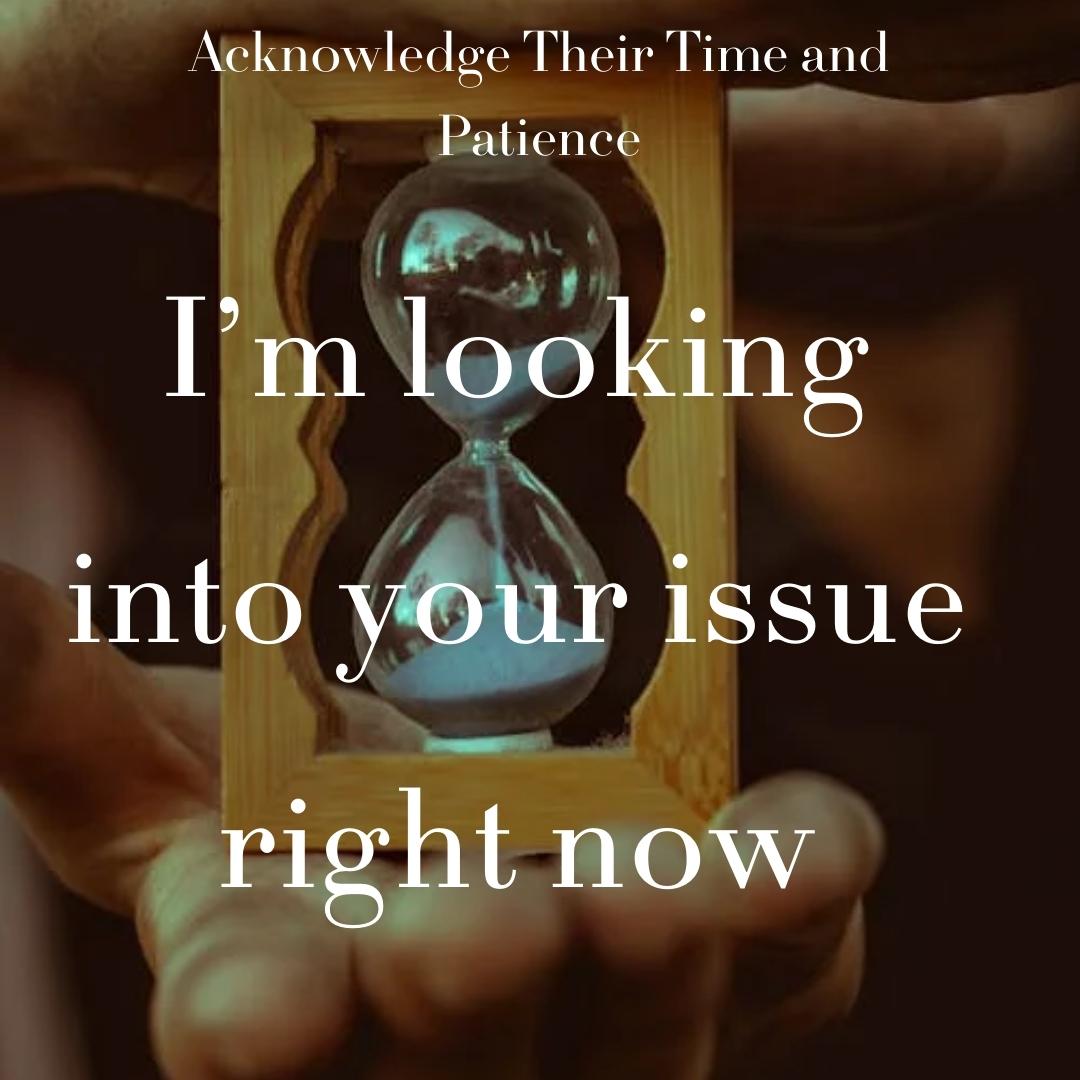
Empathy is a crucial part of delivering great customer service. It helps customers feel heard, valued, and understood, which can be a game-changer when resolving issues.
In this article, I’ll share some of the best empathy statements you can use to create a better customer experience.
These examples will help you build trust and loyalty, making your customers feel like they’re talking to a real human who truly cares about their problems.
According to research conducted by the customer service platform Dixa, 83% of people will spend more money after having a positive experience.
Let’s start with different situations and examples of using empathy correctly.
Show You Understand Their Frustration

-
“I’m sorry you are having this problem.”
-
“That would frustrate me too.”
-
“I understand how frustrating this must be.”
-
“I hear you.”
These statements are great for acknowledging that the customer’s feelings are valid. This immediately shows that you’re on their side.
Example
- Customer: “I’ve been waiting for hours, and no one has gotten back to me!”
- You: “I’m really sorry you’ve had to deal with this. I can understand how frustrating that must be.”
Validate Their Emotions

-
“I can understand how you feel.”
-
“I appreciate your patience.”
-
“Thank you for bringing this to our attention.”
-
“I would feel the same way in your situation.”
Sometimes, all a customer wants is to know that you get where they’re coming from. These empathy statements are great for validating their emotions, making them feel heard.
Example
- Customer: “I feel like no one cares about my issue!”
- You: “I totally understand how you feel. Your concerns are important, and I’ll make sure we take care of this.”
Reassure Them That You’re Here to Help

-
“I’m here to help you through this.”
-
“I understand how important this is for you.”
-
“I’m truly sorry for any inconvenience this may have caused.”
-
“I can see how frustrating this must be for you.”
Let your customer know that you’re on their team, ready to fix things. These statements are key for reassuring them that you’re here to support them.
Example
- Customer: “I just need someone to help me fix this!”
- You: “I’m here to help you through this. Let’s work together to get this resolved.”
Express Sincere Apologies

-
“I understand your concern, and I’m going to do everything I can to resolve it.”
-
“I can only imagine how upsetting this must be.”
-
“I’d feel the same way if I were in your shoes.”
-
“I’m so sorry you’re experiencing this.”
A sincere apology can go a long way in diffusing a tense situation. These empathy statements show that you’re taking the issue seriously.
Example
- Customer: “I’ve had nothing but problems with your service.”
- You: “I’m really sorry you’re experiencing this. Let me try to make things right for you.”
Emphasize Active Listening

-
“I completely understand your frustration.”
-
“I know how disappointing this must be.”
-
“Thank you for sharing that with me.”
-
“Let me know if I’ve understood your problem correctly.”
It’s not just about listening but showing the customer that you’re really paying attention. Using these statements confirms that you’ve heard their problem correctly.
Example
- Customer: “This is so confusing. I just don’t get it.”
- You: “I hear you. I know how confusing this can be, and I’m here to help clarify things.”
Acknowledge Their Time and Patience

-
“I understand you’re pressed for time; I’ll do my best to provide a quick resolution.”
-
“I’m looking into your issue right now.”
-
“Our team is working to resolve this as quickly as possible.”
-
“I can see why you’d be upset about this.”
Respecting the customer’s time shows that you value them. These statements are helpful when they’ve been waiting or feel like their issue is being dragged out.
Example
- Customer: “This has been such a long process.”
- You: “I get how frustrating it is to deal with a lengthy issue like this. Let’s work together to get it sorted as fast as possible.”
Let Them Know You’re on Their Side

-
“I’m really sorry you’ve had to deal with this.”
-
“I’d be upset too if this happened to me.”
-
“We’re going to get this sorted for you.”
-
“I completely get where you’re coming from.”
These empathy statements let the customer know that you’re on their side, not just following a script. It helps build rapport and makes the customer feel more comfortable.
Example
- Customer: “I’ve been bounced around from department to department!”
- You: “I completely get where you’re coming from, and I want to make sure you get the help you need right now.”
Be Solution-Oriented

-
“I appreciate how important this is to you.”
-
“I understand how this could have been confusing.”
-
“I apologize for the inconvenience you’ve experienced.”
-
“Let me try to make this right for you.”
After acknowledging the issue, it’s essential to move toward a solution. These empathy statements show you’re ready to take action and fix things.
Example
- Customer: “I just want this sorted out!”
- You: “Let me try to make this right for you. Here’s what I can do to resolve the issue.”
End on a Positive Note

-
“I’m so sorry this has happened to you.”
-
“I understand your frustration, and I’m here to help.”
-
“I understand this isn’t the experience you expected.”
-
“I appreciate your understanding while we work to resolve this.”
Closing the conversation on a positive note helps ensure that even if the customer is still unhappy, they know you’re trying your best to resolve the issue.
Example
- Customer: “I didn’t expect this to happen.”
- You: “I understand this isn’t the experience you were expecting. I’m going to make sure we turn this around for you.”
The Importance of Empathy in Customer Retention

Empathy goes beyond just solving immediate problems. It’s a key driver of customer retention. When customers feel genuinely understood, they are far more likely to stick with your brand, even if things go wrong occasionally.
Why Empathy Drives Retention?
- Emotional Connection: When customers feel like they are talking to a real person who understands their emotions, they’re more likely to return.
- Trust Building: Empathy helps establish trust, and trust is a foundation for long-term customer loyalty.
- Problem De-escalation: When an empathetic response is given during a complaint, customers are less likely to churn due to a single negative experience.
Example
- Customer: “I’m thinking about canceling my subscription because this has been a frustrating experience.”
- You: “I completely understand how you feel. I would feel the same in your shoes. Let me see if there’s something we can do to make this right and keep you happy with our service.”
How Empathy Impacts Customer Experience Metrics
Customer experience metrics like Customer Satisfaction (CSAT), Net Promoter Score (NPS), and Customer Effort Score (CES) are critical indicators of your service effectiveness.
Empathy plays a significant role in improving these metrics because when customers feel valued, they’re more likely to provide positive feedback.
How Empathy Boosts These Metrics
- CSAT: Empathy directly influences satisfaction. When customers feel heard, they are more satisfied, even if the problem isn’t solved immediately.
Example: “I understand your frustration, and I’m committed to resolving this. Thank you for your patience as we sort this out.”
- NPS: Happy, emotionally connected customers are more likely to recommend your company.
Example: “I’m really sorry you had this experience. Let’s turn this around and get it sorted so you leave feeling good about our service.”
- CES: Empathy reduces the perceived effort it takes for customers to get help. If they feel their concerns are understood, they’ll feel like the process was easier.
Example: “I’m here to make this as easy as possible for you. Let me take care of the details.”
Why This Matters
- Customers who feel like their concerns are being handled with care are more likely to rate the interaction positively.
- Higher empathy leads to higher NPS scores, translating into stronger customer advocacy.
The Fine Line Between Empathy and Over-Apologizing
While expressing empathy is critical, it’s important not to overdo it with constant apologies.
Too many apologies can sound insincere or shift the focus away from the solution.
Customers want to feel understood, but they also want to know that you’re actively fixing their problem.
How to Balance Empathy and Action
- Don’t Apologize Too Often: One sincere apology is usually enough. After that, shift the focus to resolving the issue.
Example: Instead of repeatedly saying, “I’m sorry for the inconvenience,” try: “I understand this has been frustrating, and here’s what I’m doing to make it right.”
- Pair Empathy with Solutions: Acknowledge the customer’s feelings, but immediately follow it with how you’re going to resolve their issue.
Example: “I completely get why you’re upset about this. Let me walk you through what I’m going to do to fix it.”
- Stay Positive: Use empathy to connect emotionally but remain positive and solution-oriented throughout the conversation.
Example: “I understand how this could have caused stress. The good news is, we can resolve this today.”
FAQs
How can I train my customer service team to show more empathy?
Training customer service teams to show more empathy can be done through active listening exercises, role-playing real customer scenarios, and offering feedback on actual interactions. It’s essential to focus on emotional intelligence development, helping agents understand and respond to customer emotions effectively.
Why is empathy important for customer service metrics like CSAT and NPS?
Empathy directly impacts metrics like CSAT and NPS because it makes customers feel heard and valued. When customers feel understood, they are more likely to rate their experience positively and recommend the company to others, boosting both satisfaction and loyalty scores.
Can showing too much empathy in customer service backfire?
Yes, overdoing empathy, especially through constant apologies, can come across as insincere or deflect from the actual issue. Customers want to feel understood, but they also want solutions. Balancing empathy with action is key to avoiding frustration.
What are the signs that my customer service team lacks empathy?
Signs that your team lacks empathy include frequent customer complaints about feeling ignored or dismissed, low customer satisfaction scores, and high rates of customer churn. If customers consistently feel misunderstood or unsupported, it may indicate a lack of empathy in interactions.
Is empathy more important than efficiency in customer service?
Both are equally important. Empathy helps build rapport and trust, while efficiency ensures problems are solved quickly. The best customer service combines empathy with effective solutions, making customers feel both valued and satisfied with the outcome.
Final Verdict
When combined with action and efficiency, empathy can elevate the customer experience, drive better outcomes, and even increase customer retention.
Training your customer service team to use empathy strategically will not only improve customer service metrics like CSAT and NPS but also build long-lasting relationships with your customers.
















